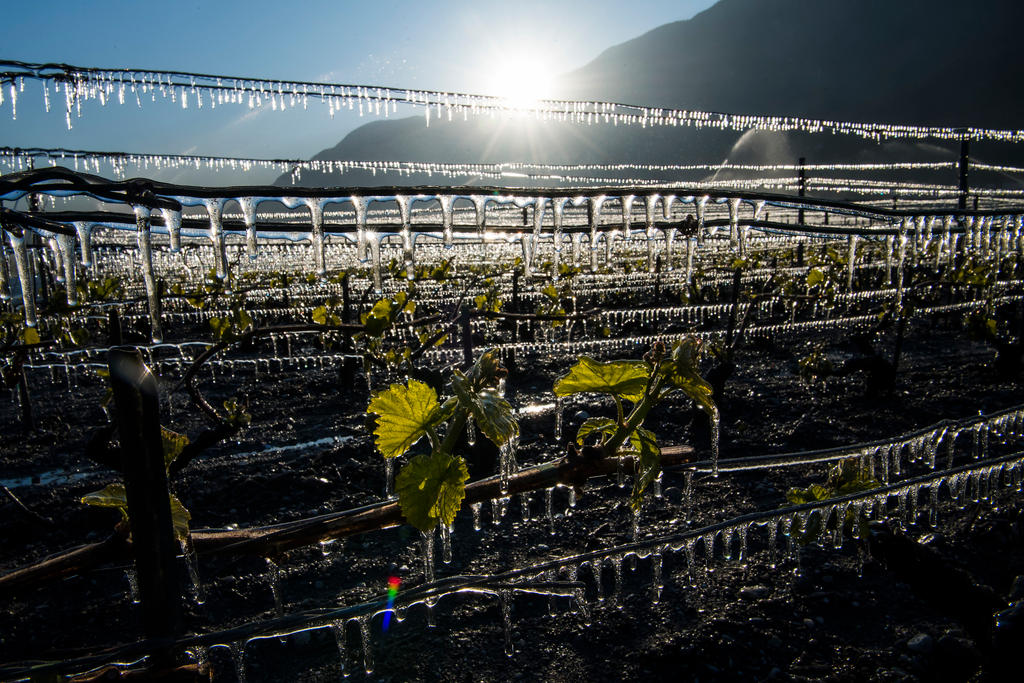Valais 2017 vintages can be mixed with other regional Swiss wines

Valais winemakers can mix their 2017 regional vintages with wines from other cantons. This exceptional economic measure, granted by the cantonal government for one year, follows serious frost damage to the grape harvest. But not everyone is happy.
The Valais cantonal government said in a statement issued on Thursday that it had “responded favourably to a request by the l’Interprofession de la Vigne et du Vin (the winemakers’ association) to allow AOC (Appellation d’Origine Contrôlée) Valais wines to be mixed with 10% of other Swiss AOC wines”.
This exceptional measure, which will last for one year only, concerns 2017 vintages such as fendant (chasselas) AOC Valais white wines, and red and rosé AOC Valais wines – mainly pinot noir and gamay grape varieties.
The decision to allow these Valais wines to contain a little bit of wine from other cantons was taken following damage to these grape varieties after an unusual end-of-April frost. Switzerland experienced sudden cold weather and mountain snow in late April following an unseasonably warm spell, which damaged many plants just beginning to bloom. The frost devastated 40% of vineyards in canton Valais, causing losses estimated at CHF100 million ($104 million).
“An exceptional measure for an exceptional situation,” declared Valais Economics Minister Christophe Darbellay, describing Thursday’s decision.
Regulations
Under national rules, Swiss wines from different regions can be mixed together if the wines have not been produced using oak chips or sweetened with grape must or similar products. However, there is no transparency surrounding such a practice or obligation to label mixed wines. Cantons do not detail the exact composition of their wines.
The winemakers’ association had urged the Valais government to apply federal rules permitting the mixing of wines between cantons up to a 10% limit. Valais legislation forbids the practice for quality reasons.
The association claims the measure will reduce the negative impact of the frost and limit the financial damage for the sector, especially for distributors and supermarket chains selling wine.
While some winemakers said Thursday’s decision was positive, others described it as a scandal.
An own-goal
“It’s an own-goal for the wine sector,” Chamoson winemaker Didier Joris told Le Temps newspaper. “This measure will endanger Valais’ notoriety.”
Paul Vetter, a wine expert and blogger, thought that winemakers seeking to produce quality wines would not implement the measure.
“Nonetheless, the decision by the Valais government introduces an element of suspicion for all wines. Valais’ image risks being seriously damaged.”
Switzerland’s wine-growing surface covers approximately 15,000 hectares (the size of Alsace). Vineyards are found in practically all the 26 cantons, in highly variable quantities. The country is subdivided into six official winegrowing regions: Valais (5,113 hectares), Vaud (3,838), German-speaking Switzerland (2,593), Geneva (1,297), Ticino (1,065) and the Three-Lakes region (940). Approximately 70% of wine drunk in Switzerland is imported.

In compliance with the JTI standards
More: SWI swissinfo.ch certified by the Journalism Trust Initiative














You can find an overview of ongoing debates with our journalists here . Please join us!
If you want to start a conversation about a topic raised in this article or want to report factual errors, email us at english@swissinfo.ch.